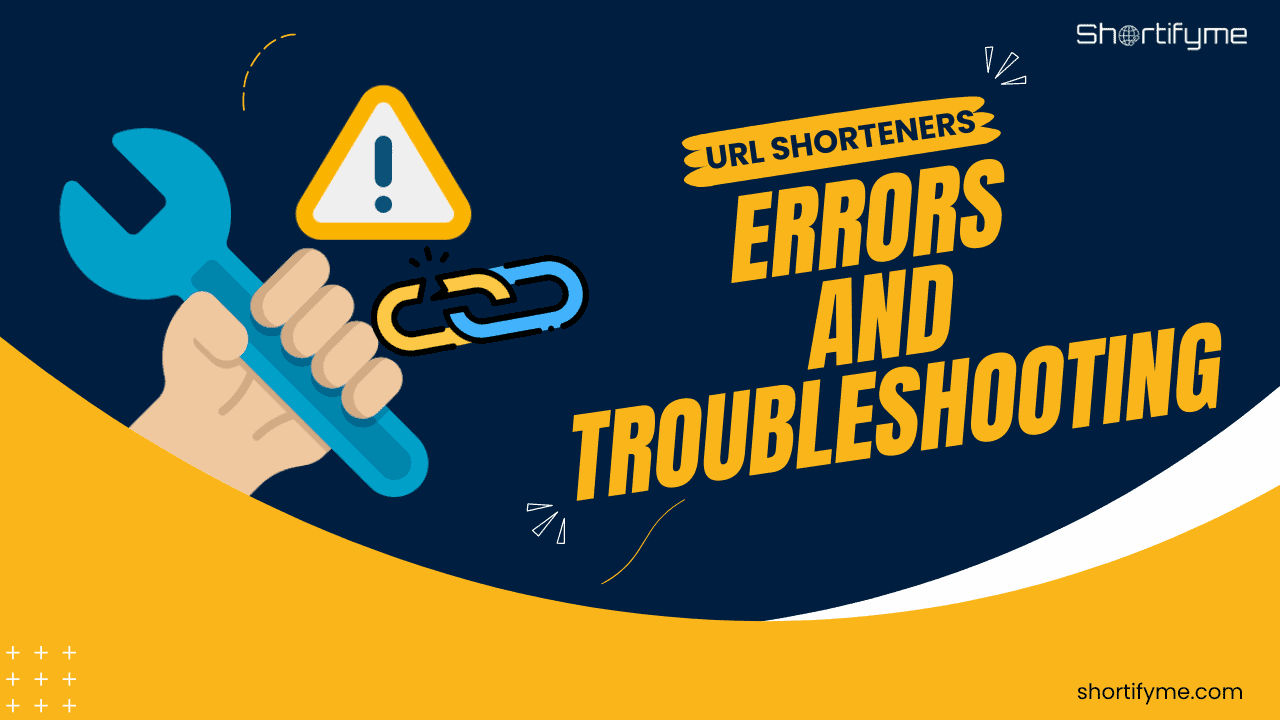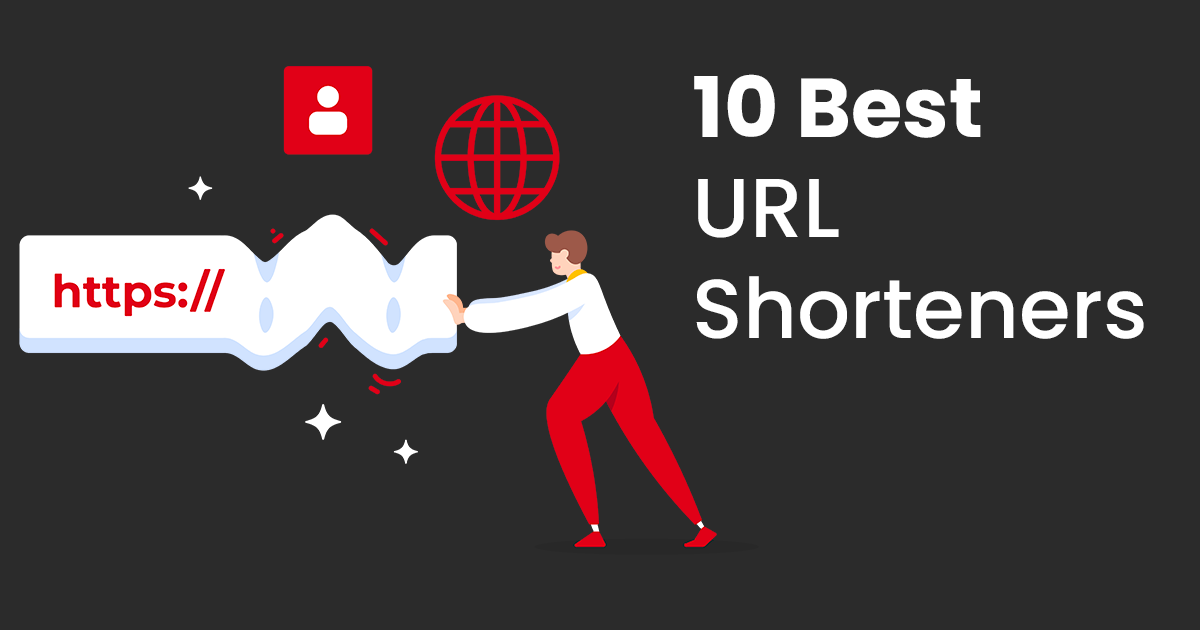URL shorteners are online tools that convert long, unwieldy URLs into shorter, more concise links. They work by redirecting users from the shortened URL to the original, longer URL. This process not only saves space but also enhances the aesthetics of the link.
Whether you’re sharing a link on social media, in an email, or a text message, short URLs make the process smoother and more efficient.
However, like any technology, they’re not without their pitfalls. Let’s delve into some common errors encountered with URL shorteners and explore effective troubleshooting strategies.
In this blog post, we’ll explore the common errors associated with URL shorteners, provide troubleshooting tips to resolve these issues, discuss other factors to consider when using URL shorteners and offer recommendations for effective utilization.
Common Errors with URL Shorteners
Just like any superhero, URL shorteners can stumble. Luckily, most errors are easily diagnosed and treated. Here are the top foes you might encounter:
Broken Links
One of the most prevalent issues with URL shorteners is the occurrence of broken links. This happens when the shortened URL no longer redirects to the intended page due to various reasons such as link expiration or deletion.
Incorrect Shortened URLs
Sometimes, mistakes happen during the URL shortening process, resulting in incorrect shortened URLs. This can lead to confusion and frustration for users who encounter error messages or reach unintended destinations.
Links Not Redirecting to the Intended Page
In some cases, shortened URLs may fail to redirect users to the intended page, leading to a poor user experience and potentially damaging the credibility of the sender.
URLs Not Working on All Devices
Another common issue is compatibility problems, where shortened URLs may not function properly on all devices or browsers. This can hinder the accessibility of the linked content and alienate certain segments of the audience.
Expired or Deleted Links
Shortened URLs have a lifespan, and if they expire or are deleted, users will encounter dead ends when trying to access the linked content. This can be frustrating and reflects poorly on the sender’s credibility.
Troubleshooting Tips
To address issues related to broken links and incorrect URL shorteners, here are some troubleshooting tips:
Double-Check The Original URL
- Before shortening a URL, it’s crucial to ensure that the original URL is accurate and active. Check for any typos or errors in the URL to prevent issues with broken or incorrect links.
- Verify that the original URL leads to the intended destination and that the webpage or content is accessible. If the original URL is incorrect or leads to a non-existent page, shortening it will only propagate the issue.
Use A Reliable URL Shortener Service
- Choose a URL shortener service that is reputable and reliable. Look for services that have a proven track record of uptime and minimal downtime.
- Opt for well-known URL shortener services offered by reputable companies or organizations. Avoid using obscure or lesser-known services that may have reliability issues or security concerns.
Test The Shortened Link Before Sharing
- After shortening a URL, it’s essential to test the shortened link to ensure that it redirects users to the intended destination.
- Click on the shortened link yourself to verify that it works correctly and leads to the expected webpage or content.
- Testing the shortened link before sharing it with your audience helps identify any issues with link redirection or incorrect destinations early on.
Verify The Link on Different Devices and Browsers
- Test the shortened link on various devices, including desktop computers, smartphones, tablets, and other devices commonly used by your audience.
- Check the link’s compatibility across different web browsers such as Chrome, Firefox, Safari, and Edge to ensure consistent performance.
- Compatibility testing helps ensure that the shortened link functions properly and provides a seamless user experience across different platforms and browsers.
Check For Any Expired or Deleted Links
- Regularly review and manage your shortened URLs to identify any expired or deleted links. Shortened URLs often have a limited lifespan, and links may expire or be deleted over time.
- Use URL shortener service features or tools to monitor the status of your shortened links and identify any that have expired or been deleted.
- Replace or update expired or deleted links promptly to prevent users from encountering dead ends or error messages when attempting to access the linked content.
By following these detailed troubleshooting tips, you can mitigate the risk of broken links and ensure the reliability and effectiveness of shortened URLs in your communications and marketing efforts.
Other Factors to Consider
Custom URLs And Their Potential Issues:
- Custom URLs allow you to create branded or meaningful shortened links that reflect your brand or campaign. While custom URLs can enhance brand recognition and trust, they may also present potential issues.
- One issue with custom URLs is that they may be more susceptible to typos or errors during manual entry. Users may mistype the custom URL, leading to broken links or redirects to unintended destinations.
- Additionally, if the custom domain or URL structure changes in the future, it could result in broken links if the old custom URLs are not properly redirected to the new URLs.
The Impact of Using Multiple URL Shorteners:
- Using multiple URL shorteners across different campaigns or platforms can complicate link management and tracking. Each URL shortener may have its own analytics and reporting tools, making it challenging to consolidate data and analyze performance comprehensively.
- Moreover, relying on multiple URL shorteners increases the risk of link management errors, such as forgetting to update or expire links when necessary. It can also dilute brand consistency if different shorteners are used inconsistently across campaigns.
Security Concerns with Shortened Links:
- Shortened links can obscure the destination URL, making it difficult for users to discern the legitimacy or safety of the linked content. This lack of transparency can be exploited by malicious actors to distribute phishing scams, malware, or other harmful content.
- Users may be hesitant to click on shortened links, especially if they are unfamiliar with the sender or the context of the link. This can result in reduced click-through rates and engagement, particularly for links shared in email or social media.
The Importance of Regularly Reviewing And Updating Shortened Links:
- Shortened links have a limited lifespan, and URLs may expire or become invalid over time. It’s essential to regularly review and update shortened links to ensure they remain active and lead to the intended destinations.
- Regular review also allows you to identify and address any issues with broken or outdated links promptly. Failure to update shortened links can result in a poor user experience, lost opportunities, and damage to your brand’s credibility.
By considering these additional factors and taking appropriate measures to mitigate potential issues, you can maximize the effectiveness and reliability of shortened URLs in your marketing and communications strategies.
Dealing With Expired or Deleted Shortened URLs
Dealing with expired or deleted shortened URLs is crucial to maintain a positive user experience and ensure the effectiveness of your marketing efforts. Here are some steps to effectively manage expired or deleted shortened URLs:
Regular Monitoring
Implement a system to regularly monitor the status of your shortened URLs. This can be done manually by periodically reviewing your list of shortened URLs or using automated tools provided by URL shortener services.
Identify Expired or Deleted URLs
Routinely check for any shortened URLs that have expired or been deleted. Look for indications such as error messages when accessing the shortened link or notifications from the URL shortener service.
Update or Replace Links
Once expired or deleted URLs are identified, take prompt action to update or replace them with valid URLs. This may involve creating new shortened URLs for the same destination or updating existing links with alternative URLs.
Redirect Expired URLs
If possible, set up redirects for expired or deleted URLs to direct users to relevant content or alternative destinations. This helps prevent users from encountering dead ends or error messages when accessing the expired links.
Resolving Issues with Shortened URLs Appearing As Spam Or Malicious
Resolving issues with shortened URLs being flagged as spam or malicious requires proactive measures to concerns and demonstrate the legitimacy and safety of the links. Here’s how to effectively manage such issues:
Use Reputable URL Shorteners
Choose reputable and trustworthy URL shortener services with a proven track record of reliability and security. Opt for well-established providers that prioritize user safety and adhere to best practices for link management and security.
Provide Descriptive Links
Whenever possible, provide descriptive or branded shortened URLs that clearly indicate the destination and purpose of the link. Avoid generic or cryptic URLs that may appear suspicious or deceptive to users.
Offer Transparency
Be transparent about the destination of shortened URLs by providing additional context or information about the linked content. Include descriptions, titles, or previews that reassure users about the relevance and legitimacy of the linked content.
Implement Link Previews
Use link preview features to display a preview of the destination webpage or content when sharing shortened URLs. Link previews help users verify the legitimacy of the link before clicking and can alleviate concerns about potential spam or malicious content.
Monitor Blacklists and Reputation
Regularly monitor URL blacklists and reputation services to identify any instances of your shortened URLs being flagged as spam or malicious. Take prompt action to investigate and address any reported issues to prevent further reputation damage.
By implementing these proactive measures, you can address issues with shortened URLs being flagged as spam or malicious, maintain user trust, and ensure the safety and legitimacy of your links.
Final Words
While URL shorteners offer convenience and efficiency, they are not without their challenges. By understanding common errors and implementing effective troubleshooting strategies, you can mitigate risks and ensure a seamless user experience.
Remember to be vigilant, choose reliable URL shortener services, and prioritize link integrity to maximize the benefits of URL shortening.
When used judiciously and with care, URL shorteners can be powerful tools for enhancing communication and sharing valuable content.
By following best practices and staying informed about potential pitfalls, you can leverage URL shorteners effectively while minimizing risks.



